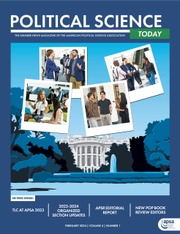The highest court in the United States, the Supreme Court, often considered a guardian of the Constitution, has a pivotal role far beyond resolving disputes. This Court may shape the interpretation and application of laws, affecting everyday life in profound ways. In the world where laws and policies are often complex and distant, it is significant to understand how crucial changes can happen even without new laws being passed. In his APSR article, Warren Snead, focusing on the US Supreme Court through labor laws, offers a novel perspective on this issue.

In this insightful article, Snead delves into how the highest court, through its decisions, can subtly but crucially change existing policies without altering their wording. This concept, known as policy drift, occurs when the conditions and contexts around a law change, causing different outcomes than intended, even though the law remains unchanged. This concept may become clearer when imagining a law as a set of rules written in a book. When that law is created, the intention is to deal with societal issues. But, as time passes, the world around us changes in various ways, for example due to new technologies or economic shifts. Despite these changes, the words in the law book remain the same. Policy drift happens when these unchanged laws begin having different impacts in the changing world. It is like having an old map of a city where the streets have changed. The map is the same, but it does not guide you the same way anymore.
Snead demonstrates that the Court can be a drift facilitator in terms of labor laws. But where does its potential to facilitate the drift emerge, and how does the Supreme Court do this? This potential comes from the Court’s institutional position within the US political system. For instance, Congress leaves policy-making authority to the judiciary intentionally and strategically by writing laws ambiguously or designing some policies that may require Court intervention. Elected officials or the congressional polarization may also necessitate and motivate Court interference to shape policy development.
To examine how the Court opens the door for policy drift, Snead focuses on the National Labor Relations Act (NLRA) as a primary example, presenting how the Supreme Court’s interpretations can reshape labor laws and, by extension, the balance of power in the workplace. The NLRA was established to protect workers’ rights, such as joining unions or the right to strike. Over time, despite no major changes in the law’s text, the way it is applied has altered. Snead demonstrates that the Supreme Court has a surprising role in this process, suggesting that the Court through its decisions can change the impact of labor laws in four primary ways: interpreting the right to strike, deciding on federal vs. state laws, enforcing labor laws, and defining who is protected by labor laws.
Snead shows that the Court ruled that employers could permanently replace workers on strike in certain situations, a decision that crucially weakened the power of strikes and strengthened the rights of businesses. The Supreme Court also decided that federal labor law overrules state and local laws, meaning that changes at the state level cannot easily address national labor issues. Additionally, the Court limited the powers of the National Labor Relations Board (NLRB), which is responsible for enforcing labor laws. This limitation makes it harder to apply labor laws efficiently. Finally, the Court narrowed the scope of who is covered by labor laws, leaving out specific groups, such as university faculties and undocumented workers. The drift is a result of the dynamic interplay between the Supreme Court’s interpretations and decisions, changing economic and social landscapes, political dynamics, legislative barriers, and labor market changes.
The unique significance of this work also lies in what it implies for future research. Although researchers still seek theories to predict times when policy drift happens, Snead offers speculation that the Supreme Court facilitates the drift when the drift’s direction aligns with the justices’ ideological leanings, when the drift supporters are knowledgeable and successful lawsuit bringers, and when Congress faces barriers on the matter. All in all, Snead’s study is not only a deep dive into legal rulings but also a reflection on their real-world implications. By looking specifically at the Supreme Court decisions on labor laws, the author shows how these determinations collectively weaken labor protections despite the original law remaining unaltered. This work also highlights a crucial point, suggesting that significant policy shifts can quietly happen, through court decisions rather than legislative changes. Understanding this process is vital for grasping how once-powerful laws can gradually lose their impact. ■


